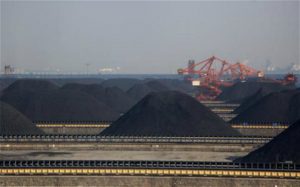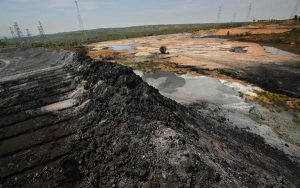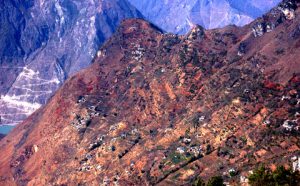“Replacing oil with gas is the right path, but making gas from coal – coal gasification – will lead us astray,” says Tao Guangyuan, executive director of the Sino-German Renewable Energy Centre. Tao gave his strong verdict against using the technology as a way to plug China’s energy gap at a Greenpeace seminar on coal gasification in Beijing in July.
Coal gas is not a new fuel and has strong critics in other countries, including the US. Before 2012, it was seen in China as an energy-intensive, highly-polluting and water-intensive industry, and its growth was restricted. However, the urgency of China’s record-breaking and persistent smog problems in east coast cities led to a rethink. The State Council issued its strictest clean air measures yet in September 2013, the Air Pollution Prevention and Control Action Plan. The plan included a call for scientific and orderly development of coal gasification as an energy source.
National Centre for Climate Change Strategy and International Cooperation Director General Li Junfeng is totally against stepping up its use. “This kind of thinking is just wrong.” He told chinadialogue: “It’s just a stop-gap measure to do this now.”
Li, who has many years of experience in energy economics and the environmental impact of energy choice, points out this is a big shift as policy stances on coal gasification have moved from “restricted”, to “cautious growth”, to “rapid growth” and now to “orderly growth”.
Water shortages
There seems no way to meet water demand for coal gasification, even before other hazards are considered. About 10 tons of water is needed to produce every 1,000 cubic metres of coal gas. Even a conservative estimate gives a water demand of 13.3 million tons of water (cubic metres) to produce annual output of 1.33 billion cubic meters of coal gas at Datang Keqi, one of China’s two currently operational plants. That’s the equivalent of four times Beijing’s daily urban water supply (about 3.1 million cubic metres).
According to Greenpeace statistics, if all 50 approved projects come into operation, those in the Inner Mongolian region will consume 742 million cubic meters of water a year. Furthermore, they will be relying on the Yellow River, which has been running low.
Datang Keqi, an experimental coal gas production plant in Inner Mongolia backed by the resources of one of China’s most powerful state-run energy providers, suffered a serious leak less than a month after going into operation. In January 2014, a hydrogen sulphide leak at the plant killed two people and injured four, proof that the safety and pollution issues of coal gas have yet to solved.
Li Junfeng told chinadialogue that, in his view, for Datang Keqi to carry on it would need new equipment and technology to ensure it is not polluting. Improvements would almost certainly increase costs.
Coal gasification is not necessarily cleaner than burning coal, nor does it economise on coal, according to research data presented by South China University of Technology professor, Qian Yu. His study discovered that using coal gasification for urban heating reduces a city’s smog from coal burning for heating by 98%. However, this method consumes 90% more coal. Greenhouse gas emissions are mostly concentrated during the production process, but increase by 65%.
Coal gasification is currently gaining from a development “bubble”, in the view of Li Shuo, Greenpeace climate and energy campaigner. “The development of other types of renewable energy haven’t yet taken off, but the country urgently needs to solve the smog problem”, he says. He predicts that renewables could be
Short-term need
For now, China appears to have scope for a growing market in coal gasification in spite of the technology’s many environmental risks and poor economic logic. There are three main reasons: First, the gravity of air pollution has pushed China’s government to step up ways to reduce coal emissions. Second, it fits with national energy security considerations. And third, in the past few years coal prices have been falling, cutting raw material costs.
Due to lower coal prices and higher natural gas prices, coal gas is currently enjoying relatively high profit margins. He Zuoyun, deputy general manager of Sinopec Great Wall Energy and Chemical Co. Ltd, said at a meeting in September 2013 that one-third of natural gas consumption could come from coal gas by 2020.
From an energy security point of view, Tao Guangyan of the Sino-German Renewable Energy Center, considers China should maintain a certain degree of coal gas production capacity, despite his strong warning against widespread use.
“It’s not favourable for China to depend heavily on overseas for its natural gas and petroleum”, he says. “China now imports a lot of natural gas from the rest of the world. This year, in May, China and Russia signed a 30-year natural gas deal worth a total US$400 billion]. Others may not supply you with gas but you cannot do without gas. At that time they’ll have their hands around your neck,” he explains.
Given the controversy, the heavyweight experts at Greenpeace’s seminar voiced doubts about development prospects for coal gasification as a power source in China.
Engineering professor Qian Yu believes possible solutions may be environmental compensation and other economic instruments. Greenpeace’s climate and energy campaign manager Li Yan is waiting to see if coal gasification can achieve a breakthrough in tackling pollution and cost issues during the current window, when other cleaner alternatives remain immature or uneconomic.
Li Junfeng, who is not at all optimistic about coal gasification, suggested production projects should be moved into more developed regions of eastern China, where he hopes higher environmental standards may force enterprises to upgrade technology to meet stricter emissions standards. It could allay widespread water consumption and pollution troubles in the west, but also cutting down on transportation costs, he suggests.







